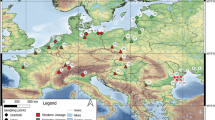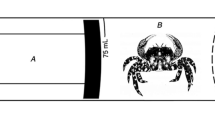Abstract
Climate change challenges plankton communities, but evolutionary adaptation could mitigate the potential impacts. Here, we tested with the phytoplankton species Emiliania huxleyi whether adaptation to a stressor under laboratory conditions leads to equivalent fitness gains in a more natural environment. We found that fitness advantages that had evolved under laboratory conditions were masked by pleiotropic effects in natural plankton communities. Moreover, new genotypes with highly variable competitive abilities evolved on timescales significantly shorter than climate change.

Similar content being viewed by others
References
Field, C. B., Behrenfeld, M. J., Randerson, J. T. & Falkowski, P. G. Science 281, 237–240 (1998).
Hays, G. C., Richardson, A. J. & Robinson, C. Trends Ecol. Evol. 20, 337–344 (2005).
Collins, S., Rost, B. & Rynearson, T. A. Evol. Appl. 7, 140–155 (2014).
Lohbeck, K. T., Riebesell, U. & Reusch, T. B. H. Nat. Geosci. 5, 346–351 (2012).
Paasche, E. Phycologia 40, 503–529 (2002).
Riebesell, U. et al. Nature 407, 364–367 (2000).
Schlüter, L., Lohbeck, K. T., Gröger, J. P., Riebesell, U. & Reusch, T. B. H. Sci. Adv. 2, (2016).
Bach, L. T. et al. PLoS ONE 11, e0159068 (2016).
Riebesell, U. et al. Nat. Geosci. 10, 19–23 (2017).
Monteiro, F. M. et al. Sci. Adv. 2, e1501822 (2016).
Lang, G. I. et al. Nature 500, 571–574 (2013).
Lohbeck, K. T., Riebesell, U., Collins, S. & Reusch, T. B. H. Evolution 67, 1892–1900 (2013).
Elena, S. F. & Lenski, R. E. Nat. Rev. Genet. 4, 457–469 (2003).
Lawrence, D. et al. PLoS Biol. 10, e1001330 (2012).
Collins, S. Proc. R. Soc. B Biol. Sci. 278, 247–255 (2011).
Scheinin, M., Riebesell, U., Rynearson, T. A., Lohbeck, K. T. & Collins, S. J. R. Soc. Interface 12, 1–5 (2015).
Schaum, C.-E. et al. Nat. Ecol. Evol. 1, 0094 (2017).
Lenski, R. E. ISME J. 11, 2181–2194 (2017).
Tatters, A. O. et al. Evolution 67, 1879–1891 (2013).
Rynearson, T. A. & Armbrust, E. V. Mol. Ecol. 14, 1631–1640 (2005).
Alpermann, T. J., Tillmann, U., Beszteri, B., Cembella, A. D. & John, U. J. Phycol. 46, 18–32 (2010).
Walsh, M. R. Trends Ecol. Evol. 28, 23–29 (2013).
Acknowledgements
We thank L. Schlüter for providing the ten E. huxleyi lineages, J. Meyer for technical assistance in the laboratory and the KOSMOS Kristineberg team for maintenance of the mesocosm infrastructure. We are also grateful for the warm hospitality of the staff at the Sven Lovén Centre for Marine Infrastructure at the University of Gothenburg. This research was funded by the German Federal Ministry of Science and Education in the framework of the Biological Impacts of Ocean Acidification II project (FKZ 03F06550).
Author information
Authors and Affiliations
Contributions
L.T.B. conceived the study, conducted the experiment, performed the measurements and data evaluation, and drafted the manuscript. T.B.H.R performed the statistical analyses. All authors designed the experiment and contributed to the manuscript revision.
Corresponding author
Ethics declarations
Competing interests
The authors declare no competing financial interests.
Additional information
Publisher’s note: Springer Nature remains neutral with regard to jurisdictional claims in published maps and institutional affiliations.
Supplementary information
Supplementary Information
Supplementary tables 1–3; supplementary figures 1–6.
Rights and permissions
About this article
Cite this article
Bach, L.T., Lohbeck, K.T., Reusch, T.B.H. et al. Rapid evolution of highly variable competitive abilities in a key phytoplankton species. Nat Ecol Evol 2, 611–613 (2018). https://doi.org/10.1038/s41559-018-0474-x
Received:
Accepted:
Published:
Issue Date:
DOI: https://doi.org/10.1038/s41559-018-0474-x
- Springer Nature Limited





